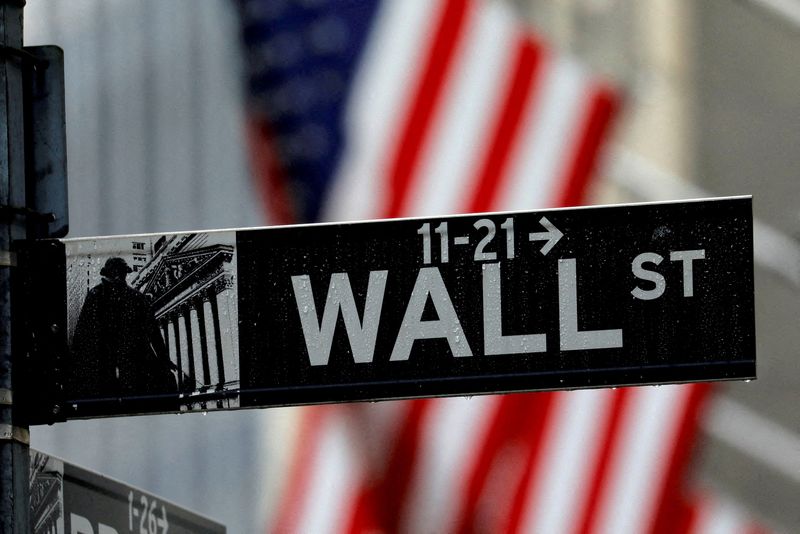![]()
Please try another search

Published Aug 11, 2023 05:15PM ET
Updated Aug 11, 2023 05:20PM ET

© Reuters. FILE PHOTO: Raindrops hang on a sign for Wall Street outside the New York Stock Exchange in Manhattan in New York City, New York, U.S., October 26, 2020. REUTERS/Mike Segar/File Photo
By Lewis Krauskopf
NEW YORK (Reuters) – Stock investors have been satisfied by middling U.S. corporate results so far this year but they might not be so easy to please for the rest of 2023.
As the second-quarter earnings season winds down, results are presenting a mixed picture, with companies beating analysts’ profit expectations at the highest rate in nearly two years even as revenue beats dropped to the lowest since early 2020.
Investors appear content with that, for now. The S&P 500 has edged higher since earnings season began in July, with the benchmark index up 16% in 2023. But expectations call for corporate profits to pick up as the U.S. economy has so far defied recession fears, and investors may be far less forgiving if companies fail to deliver later this year, given the jump in equity valuations.
“Markets are expecting earnings to … deliver above and beyond where they have been,” said Eric Freedman, chief investment officer at U.S. Bank Asset Management. “This is a market that has moved up in anticipation of earnings that we have not quite gotten yet.”
Overall, second-quarter earnings are expected to have fallen 3.8% from a year earlier, Refinitiv IBES data showed. That decline follows a 0.1% rise in the first quarter and a 3.2% drop in the fourth quarter of last year.
Results are expected to improve, however. Third-quarter S&P 500 earnings are seen rising 1.3% on a year-over-year basis, according to Refinitiv, before a 9.7% fourth-quarter earnings rise and a 11.9% full-year increase in 2024.
Meanwhile, the S&P 500 has become more richly valued. The index was trading at 19.1 times forward 12-month earnings estimates as of Thursday, compared to its long-term average of 15.6 times, according to Refinitiv Datastream. The P/E ratio ended 2022 at just below 17 times.
This year’s valuation expansion accounted for 86% of the S&P 500’s year-to-date return through July, with the rest of the market’s boost coming from positive changes to earnings estimates, an analysis by Credit Suisse equity strategists showed.
“At this point, valuations have run ahead of the fundamentals and so companies now have to prove that they can generate earnings growth,” said Anthony Saglimbene, chief market strategist at Ameriprise Financial (NYSE:).
Q2 RESULTS
With 91% of S&P 500 companies having reported second-quarter results, 78.7% posted earnings above analysts’ expectations, according to Refinitiv IBES. In aggregate, companies are reporting earnings 7.7% above expectations, up from a long-term average of 4.1% above estimates. Both the beat rate and surprise factor are coming in at their highest rates since the third quarter of 2021.
However, for revenue, only 62.9% of companies have topped expectations – the lowest beat rate since the first quarter of 2020.
Stock reaction to earnings results has also been tepid, with share prices posting weaker responses to both beats and misses than the average over the past five years, analyst Julian Emanuel of Evercore ISI said. The average stock fell 0.6% after results in the second quarter, Emanuel said in a note on Thursday.
“We went from a market that is saying, ‘Earnings had to back it up’ to ‘Thankfully earnings didn’t screw this up,'” said John Lynch, chief investment officer for Comerica (NYSE:) Wealth Management. “That just gets us into a more expensive realm.”
Meanwhile, there have also been some high profile disappointments, with Apple shares (NASDAQ:) dropping 4.8% after the iPhone maker’s weak sales forecast. Other megacap companies, such as Amazon (NASDAQ:) and Alphabet (NASDAQ:), have seen a positive investor response to their reports.
Companies reporting results next week include key retailers, such as Walmart (NYSE:) and Home Depot (NYSE:), while the release of monthly retail sales on Tuesday also could influence markets.
While investors generally have turned more positive about the economic outlook, some still are wary of a recession stemming from the delayed impact of higher interest rates, as indicators such as the Treasury yield curve are still flashing warning signs. Such a downturn could severely change the prospects for corporate earnings and potentially weigh on valuations. During recessions, earnings fall at a 24% annual rate on average, according to Ned Davis Research. “There is optimism, but I still wonder going into next year, are we too optimistic, from a consensus standpoint,” said Comerica’s Lynch. “Just because we didn’t have a recession this year, that yield curve continues to point to one.”
>>> Read full article>>>
Copyright for syndicated content belongs to the linked Source : Investing.com – https://www.investing.com/news/economy/sluggish-us-earnings-may-need-pickmeup-to-support-2023-stock-rally-3152869






























